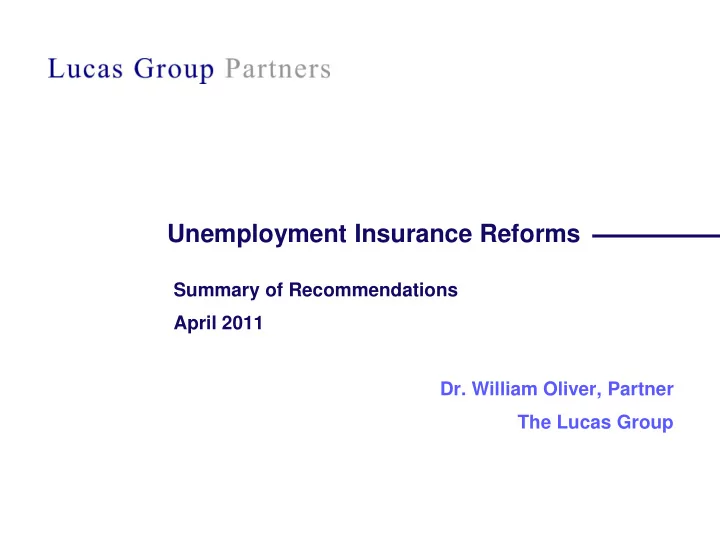

Unemployment Insurance Reforms Summary of Recommendations April 2011 Dr. William Oliver, Partner The Lucas Group
Agenda Purpose of this study The UI situation in Michigan Lucas Group recommendations Next steps 2
Purpose Purpose of the Study: The Chamber commissioned this study to evaluate and recommend reforms to Michigan’s insolvent unemployment insurance (UI) system Purpose of this Presentation: Frame the issue, outline the crisis facing Michigan’s employer -financed UI system Identify “why” we owe $4 billion to the federal government Present key legislative, administrative and policy recommendations to attack the problem – $350-$550 million in annual cost savings 3
The Situation Michigan’s employer -financed UI fund is in negative balance, down $6.4 billion in 10 years $4 billion debt (April 27, 2011) Michigan’s UI debt is the highest in the nation, behind California, giving the state a “black eye” 4
The Situation Michigan's high unemployment only accounts for 18% of the problem Fund activity has been imbalanced for a decade 4.0 Annual Benefits and Taxes Benefits 3.5 Taxes 3.0 2.5 Billions 2.0 1.5 1.0 0.5 0.0 2000 2001 2002 2003 2004 2005 2006 2007 2008 2009 2010* 5
The Situation – Cost-Drivers Three Key Cost-Drivers Also to Blame: 1. UI program is too costly • Program rife with fraud and overpayments • Eligibility rules and benefit formulas are too loose, need updating • UI program is expensive, $64 million higher than amount budgeted by the federal government 200 25 Millions of Dollars Dollars per Check Excess Over 20 150 Excess Over Standard 15 Benchmark 100 10 DOL Budget 50 AP Check 5 0 0 Compared to DOL Compared to Standards Commercial 6
The Situation – Cost-Drivers 2. UI program is too slow • Primarily an issue with the appellate system Performance Dimension Minimum Current Performance Acceptable Performance First Payment with 14* days after 87% 84.5% the end of the first compensable week Average Age of Claims Pending 40 days 22% of appeals have Higher Authority Appeals been open 180+ days Average Age of Claims Pending 30 Days 63.9% have been Lower Authority Appeals pending 40+ days Nonmonetary Determination 75% 74% Quality — Initial Claims Nonmonetary Determination 75% 93% Quality — On-going Claims 7
UI: Growing Burden for Job Providers UI Taxes are nearly 50% higher than the national average, even though benefits are about the same as other states 1.4% 350 1.2% 300 Average Benefits / Week Taxes / Total Wages 1.0% 250 0.8% 200 MI 0.6% US MI 150 0.4% 100 US 0.2% 50 0.0% 0 Average Tax Rate Average Weekly Benefit Amount 9
UI: Growing Burden on Job Providers Unless something is done, Michigan’s debt will automatically trigger higher federal UI tax rates each year for the next 10 years to repay principal on the loan Employers will also need to pay $1 billion in interest on the UI debt over the next decade • This amount is above regular state and federal UI taxes and the higher federal taxes • This situation could get worse (e.g., if the debt gets worse, Michigan experiences another recession) $5 billion in debt and interest = $1,400 per worker • Note: This calculation is made for illustration purposes only Given the size and scope of the debt, action is needed The Lucas Group recommends key legislative and administrative changes that will begin to eliminate the debt and put the program on the road to solvency 10
Major Re-engineering of UI Program Needed Recommendation How this will save Michigan Potential for Employers/Taxpayers Annual Savings Pursue fraud and abuse more Detect and capture fraud. Michigan’s recovers less $30-50 MM proactively/aggressively than 1% of claims as fraud (nationally, recover 2%) Eliminate the “pay and Eliminate overpayments, which are instances in chase” approach to claims which UIA pays claimants benefits they never were $60-80 MM management eligible for, but takes as much as a year to resolve Tie UI more closely to work Michigan benefits in two ways: (1) fewer weeks of search activities to get claims benefits, and (2) employees get back to work, $30-40 MM claimants back to work strengthening the economy Revise non-monetary Savings found by revising seasonal worker definitions, eligibility requirements gross misconduct, and requiring claimants to accept $30-50 MM (national best practices) job offers reflective of the current job market Revise monetary eligibility Savings found by making fewer weekly benefit $80-100 MM requirements payments (waiting week) Implement new benefit Savings found by implement controls to avoid benefit formula (52 weeks vs. high $150-250 MM spiking due to seasonal or other peaks in pay quarter) Create a new, quality This is fundamental to many of the other management approach to recommendations. In addition to improving quality, it $50-70 MM managing claims should reduce cost of administration $350-550 MM 11
Key Steps to Implementation Legislative Changes Overhaul the appellate system to more quickly settle claims disputes Narrow the opportunities for claimants to take unfair advantage of the system Allow more companies to be “seasonal” Eliminate the “attached worker” program Raise the bar on “suitable work” as the claim ages Increase disqualification for employees fired for misconduct Implement a waiting week Revise benefit formula to avoid benefit spiking Administrative Changes Implement commercial data mining software to find and prosecute claimant fraud and abuse Eliminate “pay and chase” – improve processes through continuous improvement and policy improvements to ensure that all eligibility determinations are finalized within the required 21 days Policy Improvements (non-legislative) Require claimants to report more details of job search activity, sufficient to audit in a meaningful manner 12
Summary $4 Billion in debt, plus $1 Billion in interest will take 10 years to repay While high unemployment is a key cause, over half of Michigan’s deficit is related to shortcomings in the program itself: Slow Inaccurate Costly System-wide reforms could reduce costs $350-550 million annually Solvent in half the time Build a solid future for workers, employers and taxpayers Policy makers need to take action – unaddressed, this problem will only get worse 13
Questions? 14
Recommend
More recommend